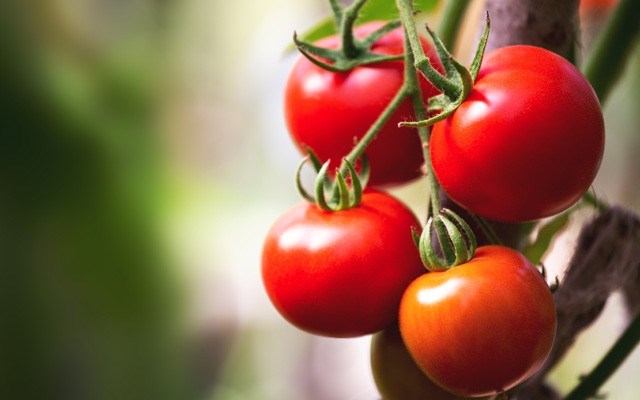A charming narrative floating around Pemberton Valley says that some of the workers on Helmers' Organic Farm work there for the tomato sandwiches alone.
This is totally understandable given farm-grown heirloom tomatoes with names like poetry — Brandywine, Black Krim, Sun Gold — are served up all summer long with the warmth of the sun still in them. Often, says Jennie Helmer, that's on toast with mayo, cucumber, cheese and cracked salt. Lordy, I might sign up to work on the farm, too, my mouth watering at the thought of those sandwiches.
Tomatoes, in their myriad forms and with their unwavering versatility, have got to be a cook's best friend. Despite their utility and popularity, we usually take these amazingly accommodating fruits — and they are fruits — for granted. But they have an exquisitely storied past.
Wild tomatoes, the forbearers of our contemporary cultivated ones, originated in the northern Andes in an area that includes parts of present-day Peru, Ecuador, Bolivia, Colombia and Chile. The plants sprawled through tall grasses. While the small, bright red fruits — much like cherry tomatoes — may have been casually picked, Incas and other early Andean people didn't bother to cultivate the plants.
Over centuries, the tomato managed to spread northward into what is now Central America and Mexico, its tough seeds dispersed by birds into regions inhabited by pre-Mayan Indians, who domesticated the fruit that Cortes and his fellow explorers eventually took back to Europe.
The Aztecs, who called them tomatl, prized a yellow variety, which the Spaniards dispatched home. Ergo the first common European name, "golden fruit," from the Italian pomodoro, which has now lent its name to a time management system.
But the passion southern Europeans first bestowed on tomatoes — and another New World import, the eggplant — chilled when botanists identified the fruit as a member of the family, Solanaceae, whose members include belladonna and deadly nightshade.
So the tomato was toyed with (recipes for its preparation are included in early herbal books), albeit with caution — much like one enters certain love affairs. Venetian Pietro Antonio Michiel wrote in his 16th century herbal: "If I should eat of this fruit, cut in slices in a pan with butter and oil, it would be injurious and harmful to me." Huh.
Yes, the leaves and stems of the tomato plant are mildly poisonous, but the toxic alkaloids responsible are totally inert and harmless in the fruit.
The irony is that while it suffered endlessly in the kitchen, the tomato's popularity grew as an ornamental plant. Gardeners prized it as a fast-growing cover for arbors and outhouses. The English cultivated tomatoes for some 200 years before daring to eat them.
French settlers in Quebec and New Orleans used the tomato for ketchup by the late 1700s, but it was rarely seen in North American markets, certainly nothing like today, when half the produce vendors at Whistler Farmers' Market offer freshly grown tomatoes
For this, we have to thank one New Jersey eccentric who was crazy enough to try and convince farmers to plant fields of tomatoes.
In the early 1800s, Robert Gibbon Johnson was so sure tomatoes were not only edible but delicious that he boldly announced he would eat not one, but several tomatoes in full view of anyone who cared to watch. On the courthouse steps in Salem, N.J. he consumed — gasp! — an entire basket of tomatoes from his garden. And not a drop of mayo in sight. Reports were that some nearly fainted at the sight of it all.
I quietly salute dear Robert Johnson each time I chop a fresh tomato or open a tin of them to add to my favourite casseroles (something else from history!).
I know, I know — a lot of you have given up on tomatoes, at least the ones you usually get at your grocery store. Cardboard tomatoes, my mom calls them. Hard, tasteless. Tomatoes in name only.
But the luck of it is we have hard-working farmers throughout Sea to Sky and beyond (I'm thinking of Lillooet and the Okanagan here) who grow and deliver super-delicious tomatoes to some local stores, and especially your local farmers' markets. The Sturdys at North Arm Farm, for one, purveyors of all kinds of fresh produce, including tomatoes, to chefs extraordinaire throughout the corridor right down to Vancouver, are masters at growing all kinds of cherry tomatoes to die for, and I mean that in the metaphoric sense.
Here's the ticket — maybe the best tip you'll ever read here: Just freeze them!
Buy these gorgeous fruits by the bushel now and enjoy them year-round, cooked or juiced or in salsa (they're mushy when thawed). First, wash your tomatoes well. To freeze them whole, nip out the stems and stem scars if you like (I don't bother). Dry them. Place them on a cookie sheet and freeze till they're solid, then bag them up in freezer bags. Or, if you're feeling particularly "whatever," just wash and stem them, then bag them whole. They might stick together frozen, but you can usually pry apart the amount you want.
Alternatively, you can wash and stem your tomatoes, then chop them up into containers and freeze. If you don't want skins, blanche them by plunging them into boiling water for a minute or two until the skin splits, then peel them.
Even if you buy one or two extra bags this time of year and freeze them, you'll be thrilled to find them at the back of your freezer one dreary January afternoon, then cook up a taste of summer for dinner.
Glenda Bartosh is an award-winning journalist who hated tomatoes when she was a kid.




